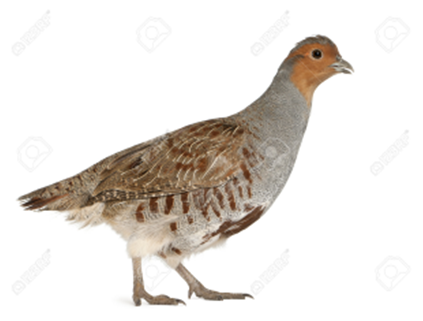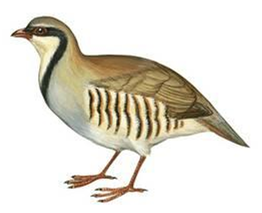LINK TO PDF NEWSLETTER DOWNLOAD

A plump chickenlike bird with a rotund body, a small head, short tail, and a short, thick bill. Flies on short and rounded wings. The belly is white, usually marked with a large chestnut-brown horse shoe mark in males, and also many females.
Hens lay up to twenty eggs in a ground nest. The nest is usually in the margin of a cereal field, most commonly winter wheat. Grey partridges prefer to run rather than fly from predators in open areas.
During winter the birds burrow 10-to-15 foot long tunnels, under the snow to reach food and shelter, spending much of their time in them. They also tend to congregate into large coveys, huddling together in a circle with each facing outward for warmth.
Also known as the gray-legged partridge, English partridge, Hungarian partridge, or Hun is a gamebird in the pheasant family. The scientific name is the Latin for “partridge”, and is itself derived from Ancient Greek perdix.
The Grey partridge, introduced from Europe and Asia in the last century. The earliest attempt at introduction, which so far as known was made by Richard Bache, son-in-law of Benjamin Franklin, who stocked his plantation on the Delaware River near what is now the town of Beverly, New Jersey with Hungarian partridges, dates back to the latter part of the eighteenth century.
The Calgary Fish and Game Association introduced Grey partridges to Alberta around 1908. The first 15 pairs were from Hungary, which is why locals often call these birds “Huns.”
The Chukar (pronounced “chew car”) partridge has well-marked black and white bars on the flanks and a black band running from the forehead across the eye down the head to form a necklace that encloses a white throat. Native to Asia, the species has been introduced into many other places and feral populations have established themselves in parts of North America and New Zealand. This bird can be found in parts of the Middle East and temperate Asia.

· The Chukar partridge was named after its common, very noisy song ‘chuck-chuck-chukar-chukar’
· Because of their pugnacious behavior during the breeding season, Chukars are kept in some areas as fighting birds





